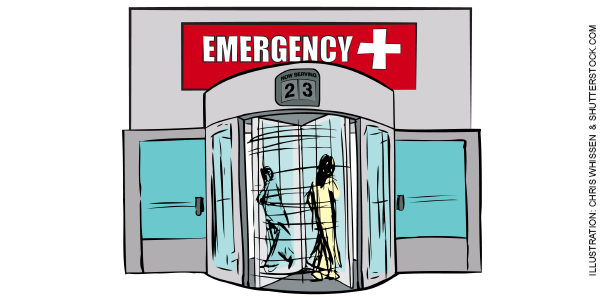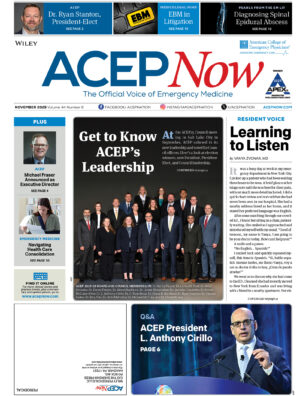
As part of the triple aim, there is a very concerted effort to develop markers of high-quality care in all of American health care. The Centers for Medicare and Medicaid Services has developed reporting and payment targets for physicians and for hospitals, and a significant amount of reimbursement will be based on performance measures.
Explore This Issue
ACEP Now: Vol 37 – No 03 – March 2018For more than 20 years, emergency physicians have been faced with hospital programs that report ED return visits, usually in a 72-hour window. Multiple studies have characterized the return visit rate as a poor marker of quality. Definitions have been unclear, and strategies to address associated factors have been very nonspecific.
One study of return visits focused on the patient-driven factors.1 Emergency medicine is a specialty driven by timeliness of care and perceived patient need. Research has found that patients used the emergency department based on their perception of good value. Patients returned due to perceived inability to access timely follow-up care, needed care that was not available, and concern about the progression of the original medical problem. The majority of patients had a primary care physician but felt that resources needed for completion of care would be accessed in a more timely manner by returning to the emergency department.
Patient-driven factors for return visits are highlighted in the book Quality Matters: Solutions for a Safe and Efficient Emergency Department by Shari Welch, MD. Her suggestion is that emergency departments should intentionally and systematically return high-risk patients to ensure the best patient outcomes.
From a quantitative basis, the Centers for Disease Control and Prevention National Hospital Ambulatory Medical Care Survey data in this area have always been enlightening. The latest data are from the 2014 reporting year:
- About 5.7 percent of ED visits were made by patients who had been seen in the same emergency department in the preceding 72 hours.
- About 4.8 percent of ED visits were for “follow-up.”
- In about 3 percent of ED visits resulting in hospital admission, the patient had been seen in the same emergency department within the prior 72 hours.
This is a very important baseline history. Other studies have found return rates to any emergency department in a particular region average 7.55 percent over a five-year period.2,3 These authors reflect on the utility of regional health information exchanges to further track and improve the care of patients having return visits and further improve the value of the emergency department in providing care for patients with ongoing medical issues that did not result in inpatient care on the initial visit.
Reasons for return visits to the same emergency department may include a scheduled revisit for wound check, the worsening of an original medical problem, a complication from the treatment, repeat diagnostics or treatment, the desire for reassurance, and many others. When the patient visits another emergency department, some other factors may be causative. It may reflect movement to a higher level of care. It may also reflect an initial patient encounter that was unsatisfactory, ended with a concern that wasn’t addressed, or was followed by a complication.
With these many factors in the mix, it is very likely that return frequency does not accurately reflect quality.
There is benefit to timely data collection and sharing among emergency departments. The Emergency Department Benchmarking Alliance is a large group of high-performance American emergency departments that share a commitment to quality and development of performance measures that has served its member hospitals and the industry since 1994. However, the return visit issue is not an area that the alliance has identified as an important quality or performance measure, even with repeated efforts to differentiate “scheduled” and “unscheduled” return visits.
In the development of the Clinical Emergency Data Registry, ACEP evaluated potential quality measures that could be utilized. The return visit issue was discussed and dismissed. ACEP’s decision may portend the eventual death of this quality measure for both research and performance comparison.
Some payer-supported work is critical of ED work that results in a bounce back and admission.4 However, recent systematic studies concluded that return visits resulting in hospital admission are not an indicator of poor care.5,6 These ED visits may be a fruitful source of cases for quality improvement activities, but they rarely identify deficiencies in initial ED care and are associated with shorter, lower-cost admissions when they do occur. It was suggested that high-quality care occurs when patients are seen in the emergency department, undergo appropriate testing and treatment, and are released because they do not meet admission criteria. The discharge instructions to “return if the condition worsens or if there are complications of treatment” result in less cost and exposure to hospital comorbidities for many persons and, on average, shorter stays for patients who choose to return.
A strategy of encouraging return ED visits may be very prudent. That is likely a satisfier for ED patients and their families, and it accurately reflects the value of having emergency departments available for patients, especially for return visits.
References
- Rising KL, Padrez KA, O’Brien M, et al. Return visits to the emergency department: the patient perspective. Ann Emerg Med. 2015;65(4):377-386.e3
- Shy BD, Kim EY, Genes NG, et al. Increased identification of emergency department 72-hour returns using multihospital health information exchange. Acad Emerg Med. 2016;23(5):645-649.
- Shy BD, Loo GT, Lowry T, et al. Bouncing back elsewhere: multilevel analysis of return visits to the same or a different hospital after initial emergency department presentation [published online ahead of print Sept. 27, 2017]. Annals Emerg Med.
- Duseja R, Bardach NS, Lin GA, et al. Revisit rates and associated costs after an emergency department encounter: a multistate analysis. Ann Intern Med. 2015;162(11):750-756.
- Sabbatini AK, Kocher KE, Basu A, et al. In-hospital outcomes and costs among patients hospitalized during a return visit to the emergency department. JAMA. 2016;315(7):663-671.
- Cheng J, Shroff A, Khan N, et al. Emergency department return visits resulting in admission: do they reflect quality of care? Am J Med Qual. 2016;31(6):541-551.
Pages: 1 2 3 | Multi-Page






3 Responses to “Return ED Visits: Poor Performance or Flawed Metric?”
March 25, 2018
Carlos DuarteIn the same manner in which you outline why return visits to ED is a poor marker of ED quality, we need to do away with using total length of stay (LOS) for discharged patients as a marker for ED quality. The CMS website notes that shorter LOS for discharged ED patients is “better” without qualifying this. The implication is that an efficient ED will be able to process all its discharged patients quickly and without delay, and that getting “in and out” quickly is better than staying in the ED for an extended period of time. What CMS (and developers/proponents of this specific measure) fail to understand is:
– we have an aging population, in which multiple comorbidities, long drug lists, poorer communication skills, means an ED physician has to spend more time sifting through these confounders, which adds to LOS. Trying to skip review of these confounders in order to decrease LOS would be foolish.
– similar to above point, an 80 y/o cancer patient with CHF, DM, CAD, PVD who presents with fever and sore throat is a much different workup than the 8 y/o child with ST who is otherwise healthy. Increasing age & increased complexities of patients makes for increased LOS in order to appropriately address the chief complaint.
– PCPs recognize the above issues, and will preferentially send such patients to the ED rather than direct-admit them, or work them up in office/outpatient setting. These patients get extensive workups, including advanced imaging such as CT, and yet many are discharged – they received outstanding yet temporally-long comprehensive assessment that CMS does not value as “better”. This practice by PCPs also adds to crowded waiting rooms, further increasing LOS (even with the best-intentioned PI to optimize flow).
– EDs are being pressured into holding patients within the ED, to complete workups that might otherwise be undertaken by the admitting physician, or to avoid “inappropriately admitting another drunk”, or to bypass inpatient psychiatric ward policies about holding a psychiatric patient in the ED rather than admit until placement can be arranged, often days of ED LOS.
– Probably most importantly, many patients benefit from prolonged ED treatment, such as IVF, breathing treatments or other repeat medications, monitoring for clinical improvement, that may not ultimately result in an admission. These patients can be in ED for several hours receiving necessary treatment, which may be entirely appropriate, but adds to LOS, which again is defined by CMS as not “better”.
– Even the argument that these patients can be placed into an observation unit does not help the LOS issue because CMS lumps the “observation stay” population with “discharged patient” population. This CMS measure should not include observation patients.
Quality should be measured by improved efficiencies, improved outcomes, lower costs, but should not be measured by shorter turnaround times. There is more to an ED visit than just getting getting them out faster, and oftentimes a longer LOS is actually better quality of care.
April 9, 2018
Robert WolfordI agree that the over all frequency of return visits within 48 or 72 hours is not a very useful metric of overall ED care. In fact there maybe too many to actually review in a timely fashion. However, a review of the reason for the return visit (especially if resulting in admission) may help to identify issues with misdiagnosis, a leading cause of malpractice actions. Identifying errors in clinical reasoning is a very difficult piece of information to obtain for the ED. By tracking errors in diagnosis, perhaps we can identify interventions to reduce their occurrence.
April 13, 2018
James Augustine, MD, FACEPThank you Dr. Wolford, for your suggestion and use of ED return visits as an important QI tool. The reason for the return visit may help to identify issues in care, communication, risk management, and needs for follow-up resources. Tracking errors in diagnosis is clearly an opportunity to educate the providers in the ED, and improve future care. Appreciate the clarification